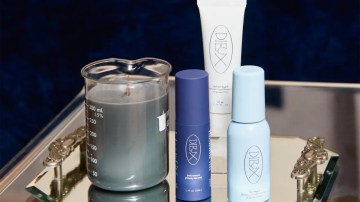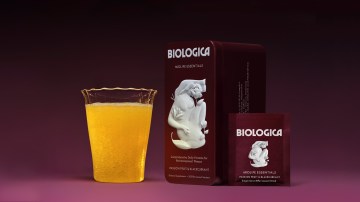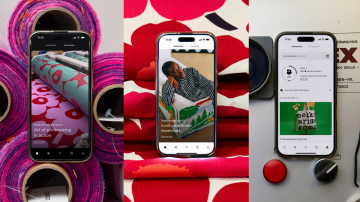All eyes are on Hailey Bieber’s Rhode Skin after its splashy entry into Sephora last month.
The beauty brand debuted in-store and online at Sephora U.S. and Canada on September 4 and sold an estimated $10 million during its first two days, according to a report published by alternative data provider Yipit.
That equated to around three Rhode items sold every second to reach 35% of Sephora’s sales on its launch day, according to the firm, which analyzes web and in-store receipt data. About 60% of Rhode’s Sephora buyers were already loyal Sephora shoppers, but a notable 40% redirected their beauty spend from Ulta, Target and Rhode’s own DTC site, according to the report. A rep from Sephora had not replied to Glossy’s request for comment at time of publication.
These data points, and the overall quick success of the line at retail, have led many industry experts to wonder about the long-term impacts on the industry as a whole.
“It was unbelievable; [the industry] didn’t expect that it was [going to be] one of the most successful launches that Sephora has ever had,” said Kimber Maderazzo, professor at Pepperdine Graziadio Business School and former Proactiv and L’Oréal executive. “It’s a message to the industry that celebrity- and community-driven brands can still succeed in multiple levels of distribution.”
Rhode’s success at retail — a first for the digitally-native, 3-year-old brand — comes on the heels of its $1 billion acquisition by E.l.f. Beauty in May.
To understand the full impact, and what may happen next, Glossy checked in with experts for how Rhode is changing the beauty game.
The beauty acquisition playbook is out
Perhaps one of the biggest takeaways is a marked shift in how brands and strategic investors may think about future acquisitions.
“There used to be an [acquisition] playbook, but this teaches us that playbooks are out,” said Maderazzo. “Instead, brands should look at when their window [of investment and acquisition] is.”
For example, many brands traditionally strive to create one successful international market, at least one lucrative retail channel, a strong DTC presence and a bouquet of hero products ahead of a strategic investment. But Bieber didn’t need this type of growth to over-index after acquisition. In fact, it may have hindered the brand to expand without support, whereas now she can easily tap into E.l.f.’s proven international supply chain of contract manufacturers.
“Strategic partners will take [community-led brands] even bigger than what they could have been if they had done it on their own,” Maderazzo said.
The relationship between strategic and brand is also shifting, said Tara Hyland, principal at private equity firm Main Post Partners, investor in brands like Milk Makeup, Dr. Dennis Gross and Too Faced.
“In most situations where there’s a large acquisition, particularly one with an enterprise value this high, you would usually assume that there are immediate synergies [in distribution or supply chain],” Hyland told Glossy. “But this is [E.l.f. Beauty’s] first entrance into prestige and into a DTC-only brand at the time.”
What’s more, “It’s been very infrequent that we see a brand that leans so heavily on one influencer [get acquired because] the risk could be so big [if the influencer makes a public misstep],” Hyland said.
Category organization of specialty retail
“Traditionally, we’ve always said that skin care, color and fragrance [should have their own sections], but we’re starting to see those categories blend together,” Maderazzo told Glossy. “Consumers are not going to be buying products vertically anymore, they’re going to be shopping horizontally.”
For example, Rhode’s hero products include color, lip and skin care, but Sephora kept the line merchandised together for maximum brick-and-mortar impact. This is juxtaposed with other brands where skin care, color and fragrance may be split up.
Maderazzo believes that this is Gen Z’s preferred way to shop, thanks to their love of brands over products, which is perfectly exemplified in Rhode’s launch. This may lead specialty beauty retailers to group all brand offerings instead of organizing them by category.
Accessible luxury is the new prestige
In a cash-strapped future where inflation and tariff pressures are high, Rhode occupies a pricing sweet spot. It’s more expensive than big-box masstige offerings but less than traditional prestige. This is also where many of its competitors live, including Laneige and Caudalie.
Unlike masstige, which elevates mass with better packaging and formulas, Rhode is prestige quality for cheaper pricing, which offers more value, Maderazzo said. For example, in a head-to-head pricing lineup, Rhode comes in $2, $14, and $5 cheaper than competitors like Rare Beauty, Summer Friday and Kosas when looking at blush, hydrating face mist and lip treatment balm, respectively.
“It’s accessible luxury [that’s] training consumers that they can go back and forth — that there is no mass, there is no prestige, there’s kind of this in-between,” Maderazzo told Glossy. “It changes the retailer game between Sephora and Ulta, and it really changes it for the consumer, too.”
Young consumers crave sheer, lightweight color cosmetics
“Our more recent reports show that younger consumers are still shopping for makeup a great deal,” Joan Li, senior analyst of U.S. beauty and personal care at Mintel market research company, told Glossy. “They’re trying new products all the time, but the ultimate goal for them in shopping makeup is to accomplish the most natural, most sheer look.”
This goes hand-in-hand with Rhode’s “glazed donut” aesthetic, which is based on hydrated, glowing skin with washes of color on the cheeks and lips. “Color [cosmetics] is no longer just something that consumers apply in the mornings to cover up their flaws,” Li said. “Makeup products have to work seamlessly with consumers’ [holistic routines], … and provide [bonuses] like sun protection and skin-care ingredients for added hydration and skin comfort.”
“Where Rhode really stands out for me is its ability to really take that hybridization of skin care and makeup and tell a very clear, aspirational story that audiences can really resonate with,” Li said. “[The brand told] those really clear, visible stories of what the blurred lines between skin care and makeup can look like and how consumers can embody it.”
Similarly, Hyland sees the future of color cosmetics sales dominated by “everyday products” in the coming quarters: foundation, concealer, blush, bronzer, mascara and eyeliner. This is in step with Rhode’s skin-first aesthetic, and a large diversion from the budgeproof matte lipstick, sparkly eye shadow palettes and liquid liner brands sold a decade ago.
Market shares within Sephora will shrink as Rhode rapidly expands
Rhode is likely to expand into other categories quickly, likely powered by E.l.f. Beauty’s international value supply chain. It could mimic the rise of Kylie Cosmetics in the mid-2010s, which was powered by partner Seed Beauty’s Colourpop value supply chain. However, the pricing ceiling for Rhode fans is not yet understood.
“In spite of being known as a generation that seeks out really affordable dupes, Gen Z and millennials are still very aspirational beauty shoppers,” Li said. “With the success of Rhode, [we see] they’re willing to pay for those premium brands that really resonate with their aspirations.”
Adds Hyland, “We’re just starting to see how much share it’s going to take.” She told Glossy that we can expect a shakeout within the sales of Rhode’s top competitors within Sephora in the next six months.




